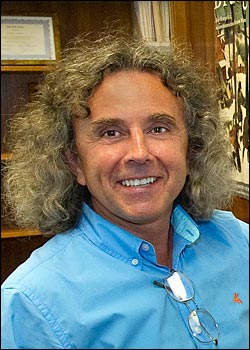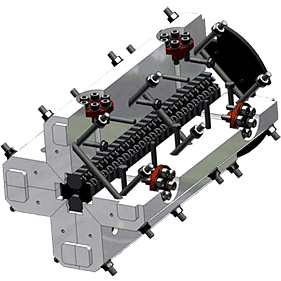If you can crash more particles into each other at Brookhaven Lab’s Relativistic Heavy Ion Collider (RHIC), you can collect more data from the subatomic wreckage. More data is just what researchers need in the hunt for answers to some of the universe’s biggest mysteries as they investigate the “perfect” liquid quark gluon plasma (QGP) revealed by previous RHIC collisions and search for the origin of proton spin. These experiments help them understand what the universe was like moments after its creation and how it evolved to become what it is today.

Vladimir Litvinenko, a physicist in Brookhaven Lab’s Collider-Accelerator Department, is leading the charge for a coherent electron cooling system to increase collision rates at the Laboratory’s Relativistic Heavy Ion Collider.
To increase collision rates, or luminosity, at RHIC and generate more data, physicists in Brookhaven’s Collider-Accelerator Department (C-AD) — in collaboration with others from Jefferson National Laboratory, Tech-X Corporation, Budker Institute of Nuclear Physics in Russia, and Daresbury Laboratory in the United Kingdom — are developing a brand new technique called coherent electron cooling. Theory predicts that coherent electron cooling can increase luminosity by an impressive factor of 10.
The particle beams accelerated and smashed in colliders such as RHIC and the Large Hadron Collider in Europe are not made up of a continuous stream of particles. Instead, they are sent through these colliders’ tunnels in groups known as bunches.
“The heavy ion beams we collide at RHIC have about 1 billion ions per bunch and the proton beams have about 100 billion per bunch,” said Vladimir Litvinenko, a C-AD physicist who is leading the charge for a coherent electron cooling system at Brookhaven. “In both cases, ion beams naturally expand, or ‘warm up.’ As that happens, ion bunches in the beams become less dense and luminosity decreases.”
There are several ways to cool an ion beam. In the electron cooling method, a beam of “cold” electrons propagates with “warm” ions. Those electrons act as a thermal bath to extract heat and cool the ions — think of cooling a pot of hot soup by placing it in a sink filled with cold water. Another cooling technique, called stochastic cooling, uses measurements of an average ion’s position to determine how much an electric field should “kick” the ions back toward their ideal positions. But these methods have limitations.
“The efficiency of electron cooling decreases as the beam’s energy increases, so this method would take too long to cool beams in RHIC,” Litvinenko explained. “Stochastic cooling, which we use at RHIC now, has worked great to ramp up luminosity, but it cannot improve the beam density to the extent we need. Plus, it only works with the heavy ion beams that contain fewer, larger particles, not the polarized proton beams that contain larger quantities of much smaller particles.”
So, Litvinenko is working with his collaborators to develop a hybrid of these two cooling methods — a coherent electron cooling system.

The free electron laser portion of the proposed coherent electron cooling system, which will amplify the electron clouds’ negatively charged electric field. When the electrons again join with collision-bound ions, the amplified electric field will pull the slower ions to accelerate and the faster ions to decelerate. Thus, the beam condenses, or “cools,” to form a tighter, denser pack.
A coherent electron cooling system for each of RHIC’s two collision-bound ion beams would operate along approximately 200 feet of the 2.4-mile-round storage rings. Here’s how it would work:
First, positively charged ions screaming along at nearly the speed of light pass through a modulator, where negatively charged electrons are added to the beam. The ions and electrons have opposite charges so they attract each other. This causes the electrons to form small clouds that envelop the ions and these small clusters of ions now encased in electron clouds then propagate within the beam.
Next, magnets separate the oppositely charged particles and direct them into two bypasses. The electron bypass contains a free electron laser with a “wiggler,” which has a series of magnets that create a periodically alternating magnetic field. The free electron laser adds more electrons to the neatly organized electron clouds to amplify the clouds’ negative charge. Meanwhile, the ions in the ion bypass maintain their pace and energy levels as they continue racing along.
Then, the ions and electrons merge back together and the electron clouds, now with an amplified electric field, act as a “kicker.” As the electron clouds attract the positively charged ions, their electric field pulls the slower ions to accelerate and the faster ions to decelerate. Thus, the beam condenses, or “cools,” to form a tighter, denser pack.
After that, the electrons are stripped and dumped while the cooler ions in tighter formations race on for a cataclysmic tango with an oncoming ion beam containing similarly cooled particles.
“Right now, the theory and tools to simulate coherent electron cooling are progressing and we expect the first start-to-end simulation package to be complete in this year,” Litvinenko said.
After that, the next step is to demonstrate that coherent electron cooling really does work. Litvinenko and his collaborators are proceeding to build a coherent electron cooler prototype capable of cooling gold ions at an energy of 40 billion electron volts (GeV). Actual experiments should start in 2015 and continue for two years.
If the experiment is successful and the funds are available, a full-size coherent electron cooler could be built in approximately two to three years.
In addition to increasing luminosity and physics productivity at RHIC, such a cooling system would also help make the case for building an electron-ion collider (EIC) at RHIC. This proposed facility, known as eRHIC, would require very high luminosity for collisions between electrons and heavy ions so physicists can probe even further into the mysteries of protons, heavy ions, and the forces that affect them. This cooling technique could also be implemented to increase luminosity at the Large Hadron Collider.